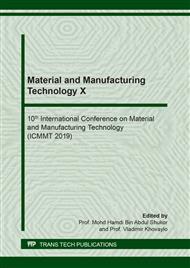[1]
Cai, J.J., Hawboldt, K., Abdi, M.A. Analysis of the effect of module design on gas absorption in cross flow hollow membrane contactors via computational fluid dynamics (CFD) analysis. Journal of Membrane Science. Volume 520, 15 December 2016, Pages 415-424.
DOI: 10.1016/j.memsci.2016.07.054
Google Scholar
[2]
Das, B. B. and Mitra, Arkadeep Nanomaterials for Construction Engineering - A Review International Journal of Materials, Mechanics and Manufacturing. Vol. 2, No. 1, 2014, Pages 41-46.
Google Scholar
[3]
Il'yushin, A. A. Work of 1946-1966. Vol. 2. Plasticity (in Russian). Moscow: FIZMATLIT, 2004. - 480 p.
Google Scholar
[4]
Bobrov, A.V., Sarbaev, B.S., Shirshov, Y.Y. Deformation and strength properties of a carbon–carbide composite with 2D reinforcement under plane stress state. Journal of Machinery Manufacture and Reliability. Volume 45, Issue 2, 2016, Pages 145-151.
DOI: 10.3103/s1052618816020035
Google Scholar
[5]
Zarubin, V.S., Kuvyrkin, G.N., Savelyeva, I.Y. Estimates of the Elastic Characteristics of a Composite with Short Anisotropic Fibers. Mechanics of Composite Materials. Volume 53, Issue 4, 1 September 2017, Pages 497-504.
DOI: 10.1007/s11029-017-9679-3
Google Scholar
[6]
Berezovskii, V.V., Solyaev, Y.O., Lur'e, S.A., Babaitsev, A.V., Shavnev, A.A., Kurganova, Y.A. Mechanical properties of a metallic composite material based on an aluminum alloy reinforced by dispersed silicon carbide particles. Russian Metallurgy. Volume 2015, Issue 10, 1 October 2015, Pages 790-794.
DOI: 10.1134/s0036029515100055
Google Scholar
[7]
O. Ndubuaku, M. Martens, A. Ahmed, R. Cheng, S. Adeeb. A novel approach for stress-strain characterization of metallic materials using the product-log (omega) function. 2017. Pages 1-10.
DOI: 10.1115/pvp2017-65236
Google Scholar
[8]
Chen, X., Wu, S., & Zhou, J. Experimental study and analytical formulation of mechanical behavior of concrete. Construction and Building Materials, Vol. 47, 2013, Pages 662-670.
DOI: 10.1016/j.conbuildmat.2013.05.041
Google Scholar
[9]
Cook, D. J., & Chindaprasirt, P. A mathematical model for the prediction of damage in concrete. Cement and Concrete Research, Vol.11, Issue 4, 1981, Pages. 581–590.
DOI: 10.1016/0008-8846(81)90088-0
Google Scholar
[10]
Djouabi, M., Ati, A., & Manach, P.-Y. Identification strategy influence of elastoplastic behavior law parameters on Gurson–Tvergaard–Needleman damage parameters: Application to DP980 steel. International Journal of Damage Mechanics. International Journal of Damage Mechanics. 2018. Pages 1-28.
DOI: 10.1177/1056789518772130
Google Scholar
[11]
Papirno, Ralph. Algebraic approximations of stress-strain curves for KEVLAR-reinforced composites. Journal of Testing and Evaluation. Volume 13, Issue 2, March 1985, Pages 115-122.
DOI: 10.1520/jte10768j
Google Scholar
[12]
Horsinka, J., Kliber, J., Drozd, K., Mamuzić, I. Approximation model of the stress-strain curve for deformation of aluminium alloys. Metalurgija. Volume 50, Issue 2, 2011, Pages 81-84.
Google Scholar
[13]
Ling, F., Wu, Z., Zhu, Y., He, C., Zhu, L. Fractal approximation of the stress-strain curve of frozen soil. Science in China, Series D: Earth Sciences. Volume 42, Issue SUPPLEMENT, August 1999, Pages 17-22.
DOI: 10.1007/bf02878848
Google Scholar
[14]
Ji, F., Qiu, Y., Bao, J., Gao, T., Zhao, Y., Qiu, X., Chu, X., Yang, R., Cheng, S., Ye, J., Zhang, N. Mathematical approximation of the stress-strain curves of fabrics. Proceedings of the Fiber Society 2009 Spring Conference. 2009, Pages 606-611.
Google Scholar
[15]
Iwamoto, N. Developing the stress-strain curve to failure using mesoscale models parameterized from molecular models. Microelectronics Reliability. Volume 52, Issue 7, July 2012, Pages 1291-1299.
DOI: 10.1016/j.microrel.2012.03.014
Google Scholar
[16]
Weber, U., Mohanta, A., Schmauder, S. Numerical determination of parameterised failure curves for ductile structural materials. Materials Research and Advanced Techniques. Volume 98, Issue 11, December 2007, Pages 1071-1080.
DOI: 10.3139/146.101573
Google Scholar
[17]
Fedorov, T.V., Morrev, P.G. A NURBS approximation of experimental stress-strain curves. Journal of Chemical Technology and Metallurgy. Volume 51, Issue 3, 2016, Pages 341-349.
Google Scholar
[18]
Sokolov, A.P., Pershin, A.Yu. Computer-aided design of composite materials using reversible multiscale homogenization and graph-based software engineering. Key Engineering Materials. Vol. 779, 2018, pp.11-18,.
DOI: 10.4028/www.scientific.net/kem.779.11
Google Scholar
[19]
Sokolov, A.P., Schetinin V.N. Modeling of phases adhesion in composite materials based on spring finite element with zero length. Key Engineering Materials. Vol. 780, 2018, pp.3-9,.
DOI: 10.4028/www.scientific.net/kem.780.3
Google Scholar
[20]
Pisarenko, G.S., Yakovlev, A.P., Matveev, V.V. Spravochnik po soprotivleniyu materialov. [Handbook on strength of materials] (in Russian). 2-d edition – Kiev: Naukova Dumka, 1988, - 736 p. – ISBN 5-12-000299-4.
Google Scholar


